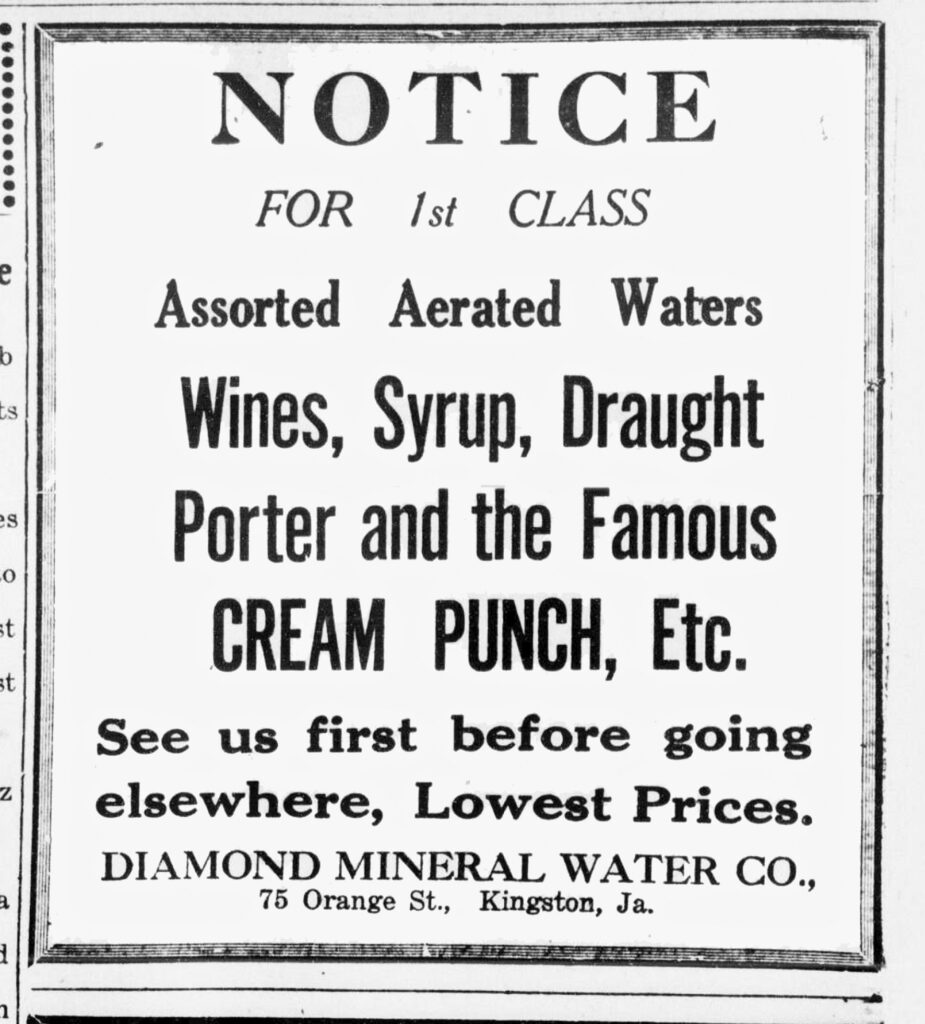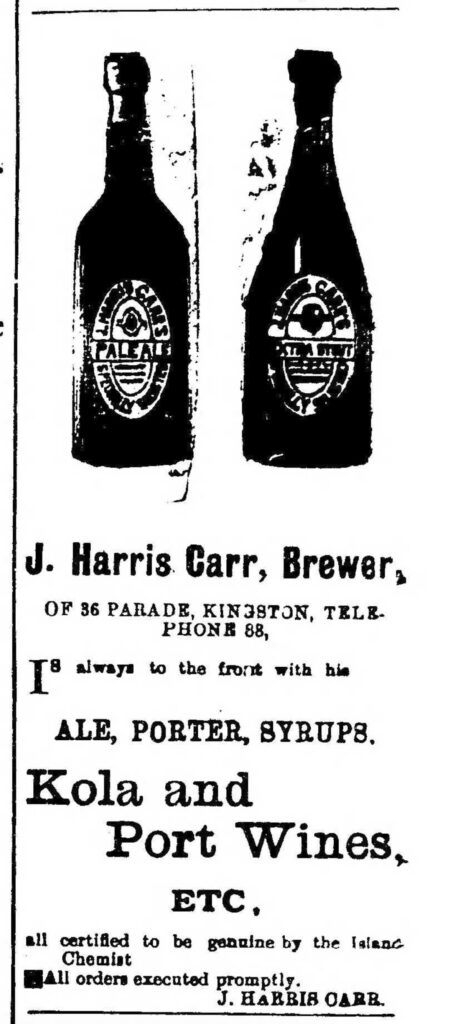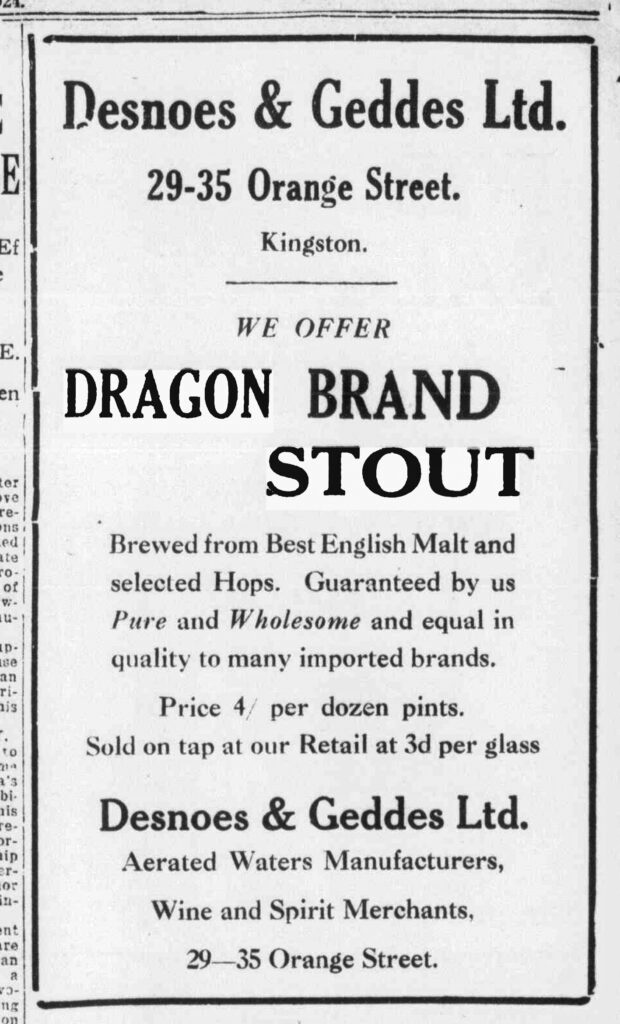The history of beer is largely working-class history, which means, given the status of working-class history, much of it is forgotten. When it’s black working-class history … Thus the long love of rural (and urban) working-class Jamaicans – and probably other West Indians as well – for draught porter is a subject you will struggle to find recorded anywhere.
Draught porter was sold from draught porter shops, in existence in Kingston, Jamaica from at least the Edwardian era; from casks in refreshment parlors that also sold fried fish and bread; and also by travelling salesmen, who would call out “draaf porter!” as they travelled on foot around rural villages in the Jamaican interior, carrying a large tin container with a spout, and cans in quart, pint, half-pint and gill (quarter-pint, pronounced “jill”) sizes, for serving. Jamaica also had itinerant ice-cream salesmen, who would sell a blend of “frisco”—ice-cream and “snow ball”, shaved ice flavored with fruit syrup, mixed together—and “a measure of draught porter for the older folks.” A report in the Kingston Gleaner in August 1936 described a treat for the “deserved poor” of Linstead, in the Jamaican countryside 20 miles from Kingston, where an “appreciable sum” was collected by the local Salvation Army to buy and distribute rations of beef, rice, bread, cake, soap and iced draught porter to more than 300 people.
Draught porter, often referred to as “drought porter,” was brewed by Jamaica’s many soda water and soft drinks manufacturers using “wet sugar,” a type of molasses made by the hundreds of small cane-sugar farmers in the Jamaican countryside and sold in tins. Draught porter retailed for an exceedingly cheap 1½ pence a glass, and was the drink of Jamaica’s poorest classes. A report by the Canadian Department of Trade and Commerce on the alcohol scene in Jamaica in 1922 said: “Curiously enough, there is a very fair demand for stout in Jamaica, despite its heating qualities. It mixes well with raw rum, but in addition it is drunk for its own worth. There is no bottled porter in the market, but there is a considerable quantity of cheap and bad draught porter of local manufacture. There is no pure food obstacle to the manufacture of this beverage in Jamaica, and it is generally believed that fermented molasses and sugar waste are used in the manufacture.”

Among the earliest firms engaged in brewing porter alongside making syrups and cordials was Frank Erskine & Co, in operation as ale and porter brewers from at least 1889 at the Sign of the Porter Hogshead, 56 Port Royal Street in Kingston. In June 1891 the company announced that it was moving to “new and larger premises” at 39 Orange Street. The founder, Frank Erskine senior, died around February 1895, and the business was carried on by his son, Frank junior, who was making XXX porter and ale, and “Syrups in any quantity, in various flavours”. However, the brewery had collapsed by April 1900 at the latest, after “business had been bad for some time.”
Just up the road at 42 Orange Street another soft drinks and soda firm, A. Fournier and Co, had built a brewery plant in 1896 which in 1900 was brewing “the best ale and porter ever made here,” according to the company itself. In 1902 it was apologizing that its “Well-known Imperial Ale and Stout will soon appear again. On account of some changes in our Brewery Department we had discontinued for a while.” By 1905, however, Fournier & Co had been taken over by its rival, the Colonial Mineral Water Co, which had dropped the ale and porter, but was still making winter stout.
Rival porter brewers in Kingston included John Harris Carr, who was born in China, came to Jamaica about 1888 and because a naturalized British citizen in 1893. Harris Carr was brewing pale ale and extra stout at 34 East Queen Street by 1894, and making fruit syrup as well. He moved to 36 South West Parade after a fire in 1896, and had added kola wine and port to his products by the following year. Harris Carr was boasting in 1899 that his business was “well known as the best and cheapest house in the city,” with a half-hearted endorsement from the government analytic chemist declaring: “I have tasted the bottles of your Extra Stout and found the contents fair average.” By 1907 he was employing around 40 Jamaicans in the business. The brewery ran until March 1918, when Harris Carr left Jamaica for the United States.

A host of little firms combined making soft drinks and/or fruit syrups with porter and ale brewing. W.T. Jervis & Co at 114 Barry Street, Kingston, advertised themselves in 1894 as “Ale and Porter Brewery and the Manufacturer of the Finest Fruit Syrups … Only Gold Medal for Crystal Sugar, Jamaica Exhibition, 1891.” The Colonial Mineral Water Co of Orange Street in Kingston in February 1898 was selling its “winter stout” alongside ginger beer, kola wine, lemonade and champagne cider. Other soft drink/mineral water makers who were also manufacturers of what was very likely molasses-based porter included W.A. Peat of Spanish Town, who was brewing Race Horse brand ale and stout in 1906, as well as making banana wine, kola wine and fruit syrup. The Direct Brewery, of Spanish Town Road, Kingston, was selling in 1908 “drought porter” at 11 pence per gallon, and the bottled version at two shillings per dozen pints, alongside syrup and liqueurs.
Edwin Charley, whose firm claimed to have been “founded 1892”, and whose business was eventually acquired by the Jamaican drinks firm Wray & Nephew (now part of Grupo Campari of Italy) was brewing ale and porter in Spanish town “in the Market in Bottle or Bulk – ask for the Cock brand and you will get no other” – from at least 1894, when he was also making “the finest Fruit Syrups … special and prompt attention given to Country Dealers” .He also occasionally sold imported brews: in August 1895 Charley had “a large stock of Bass’ Pale Ale and Double Stout just received, to be sold off cheap.” In 1898 his premises in Spanish Town were known as the St Catherine Aerated Water Factory and Brewery, and he was making was what now the regular line-up of Jamaican drinks manufacturers’ products: not just Cock Brand ale and stout (“the Brewery continues in full swing”) but Kola wine and champagne, barm beer, iron brew, soda, lemonade, ginger ale “etc etc” and fruit syrups, as well as selling port wine “in quarter casks and bottles”. By June 1907 he had moved to King Street, Kingston, but was still selling Cock Brand ale and stout (“stout” and “porter” seem to have been used indiscriminately in Jamaica) along with kola prunella wine, banana wine, sodas and the rest. Within a few months, Charley’s own ale and stout had disappeared from though offer, though the firm was now offering “Charley’s Chocolatine”, a fizzy chocolate drink. However, as a drinks dealer Edwin Charley continued to sell imported stouts, offering Tennent’s XXX stout and milk stout from Glasgow to the drinkers of Kingston in 1938.
Other trader continued to sell their own-brewed stouts. The Royal Brewery and Aerated Water Factory in Water Lane, Kingston, advertised its aerated waters, syrups and stout via a small ad in the Daily Gleaner in December 1921: “Book your orders early for the Christmas.” The Kingston Mineral Water Company in West Street, Kingston, opened in August 1930, declaring: “Our Mineral Waters Wines, Cordials, Fruit Syrups and Draught Porter etc etc will be of the best possible quality on the Market.” The Diamond Mineral Water Co Ltd, of Orange Street, Kingston, founded in 1919, was still making stout and draught porter alongside syrups, cordials, cocktails, rum, gin, brandy and other alcoholic drinks in 1955. Not surprisingly, given the sugar used in its manufacture, draught porter was a sweet drink, described as such in 1957.
In October 1939, just after the start of World War Two, the Jamaican government proposed raising the tax on beer more than fourfold, from 4½d a gallon to 1s 9d a gallon, a rise of just over two pence a pint. Brewers protested that the proposals would “affect the poorest class of person badly,” placing the price of “native” draft porter and stout “immediately out of their reach.” That would “certainly mean almost complete destruction of the industry,” which in turn would hit hard the “small country-men” who produced the hundreds of tins of wet sugar a week bought to make draft porter. The tax rise on “native” beer was withdrawn after objections in Jamaica’s parliament, brought back just nine months later, in July 1940 and thrown out again.
The biggest mineral water company in Jamaica to branch into making stout (and eventually mainstream brewing) was Desnoes and Geddes. The Desnoes family were originally coffee plantation owners on Saint Domingue, the French-controlled western end of the Caribbean island of Hispaniola, who left after the former slaves there seized independence and founded the nation of Haiti early in the 19th century. The family eventually settled in Jamaica, where Pierre Desnoes, who died in 1869, became a wealthy wine merchant in Kingston. His grandson, Eugene Peter Desnoes, entered the mineral water industry. In 1918 Desnoes merged with a rival mineral water company founded early in 1915 by Thomas Hargreaves Geddes, the Jamaica Mineral Water Factory, with the new firm, Desnoes and Geddes Ltd, based in Orange Street. Geddes, born in Spanish Town in 1880, was the youngest son of a Wesleyan clergyman in Jamaica, the Reverend Thomas Middleton Geddes.
Desnoes and Geddes imported beer from abroad as well as making mineral waters: in 1922 it was selling stout and ale from S. Oland and Sons’ brewery in St John, New Brunswick. Other imports into Jamaica included Guinness’s stout from Ireland and McEwan’s stout from Scotland. In 1924 D&G began selling “Dragon brand stout,” “brewed from Best English Malt and selected Hops … equal in quality to many imported brands.”

Two years later, in May 1926, the Gleaner newspaper reported that Desnoes and Geddes had purchased the Core Ice Factory and Cold Storage in West Street, Kingston, “and from what can be gathered they intend to reconstruct the plant in order to make it into an up-to-date brewery for the manufacture of beer.” It was another two years before the brewery opened, in large part because, with Jamaica in an earthquake zone, and the brewery buildings carrying heavy loads several stories up, it had to be built as strong as possible, with foundations going down a remarkable, for the time, seven feet.
In the meantime, in January 1928, the company announced the launch of its new trademark, the Red Stripe brand, telling customers: “All our Wine Labels are now marked with a Red Stripe … the Red Stripe means Quality—Purity—Value.” Two months after that, Desnoes and Geddes told customers to “look out for the opening of the ‘Surrey Brewery'” in Pechon Street (which runs parallel with West Street), when Red Stripe ale, stout and lager would be on sale. Thirsty Jamaicans still had a wait of several months, but on Thursday August 24 1928 the Surrey brewery was officially opened by the acting governor of Jamaica, Arthur Jelf, and Red Stripe ale and stout were on sale in the 40 or so Desnoes and Geddes-owned bars across Kingston, at two pence per small glass, four pence per large.
In 1934 D&G launched Red Stripe “extra milk stout”, which was in competition from imported milk stouts including offerings from three Scottish brewers, Younger’s of Edinburgh, James Calder and Co of Alloa and Tennent’s of Glasgow, as well as Mackeson’s, which had been sold on the island since at least 1913 by the rum distiller and drinks distributor J. Wray & Nephew, and Simonds of Reading’s milk stout. Red Stripe milk stout looks to disappear after 1940, despite being promoted as costing “far less” than rival imported brands.
In 1959 brewing operations shifted from Pechon Street to Hunts Bay, three miles away, and two years later, in 1961, the brewery’s stout was relaunched by Desnoes & Geddes under the revived name of Dragon Stout, a bottom-fermented sweet-tasting stout, like the sweet “draught porters” made by the mineral water firms, a style found today across the Caribbean, and which could be called West Indian stout or Tropical Stout: a genuine, and rare, beer style springing from black culture. It is not the most sophisticated of stouts: but if you try a glass, you are drinking authentic working-class history.


I live in Barbados and this history is fascinating: I can get Dragon Stout quite easily and it’s a beautiful, sweet, well-balanced stout. I didn’t know it was history in a glass!
Barbados now has its own craft brewery and tap room that offers draught ales and 2 stouts – the Dreadhop Brewery & Tap Room. Worth a visit if you’re travelling here (whenever that might be).
[…] Want to read more? Please click… HERE!!! […]
Interesting stuff. Dragon Stout is distributed in the UK by Heineken and my local Asda and Tesco both sell it. Well tasty, and good to know the history behind it now.
[…] In his ongoing research into porter and stout (there’s a big book on the way) Martyn Cornell continues to find new stories to tell. This week, he shone a light on the historic popularity of porter among working-class Jamaicans: […]
[…] err… second, I failed you all before Christmas by not mentioning Martyn’s post on the roots of Jamaica’s love of strong sweet […]
Last time I was in Jamaica the trend was to mix stout with redbull. Makes a little more sense with the long association of stouts and syrups, but still makes me want to wretch!